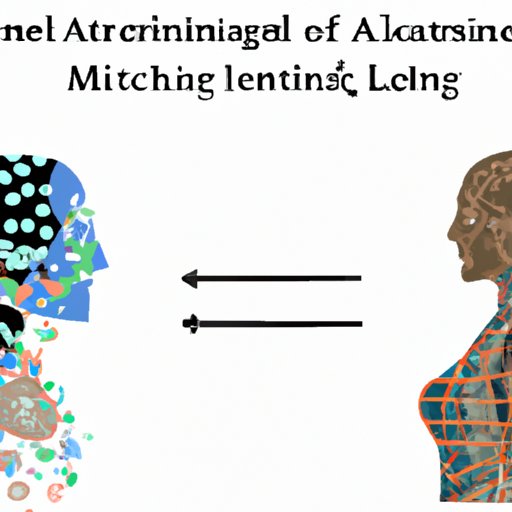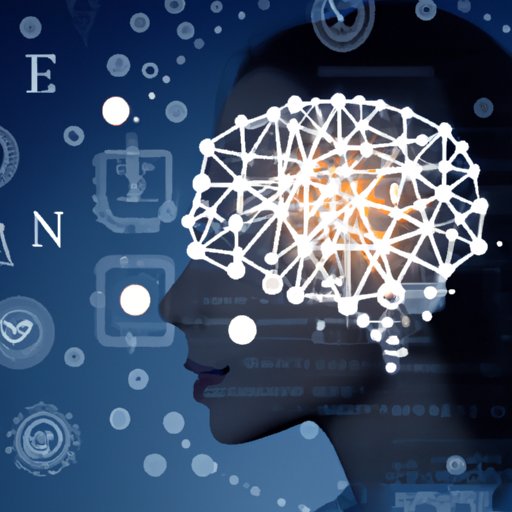Introduction
In recent years, there has been an increased focus on the potential of machine learning (ML) and artificial intelligence (AI). These technologies have revolutionized the way in which we interact with technology, from automated customer service to voice assistants. But what is the difference between machine learning and artificial intelligence? This article will explore the relationship between ML and AI, examining the benefits and challenges of incorporating these technologies in a variety of contexts. It will also look at how ML and AI are used in business and their impacts on society.

Exploring the Relationship Between Machine Learning and Artificial Intelligence
At first glance, machine learning and artificial intelligence may appear to be the same thing; however, they are two distinct concepts that are often used interchangeably. In order to understand the relationship between ML and AI, it is important to first define each term.
Definition of Machine Learning and Artificial Intelligence
According to the Merriam-Webster Dictionary, machine learning is “the development of computer programs to do tasks without explicit instructions, relying on patterns and inference instead.” In other words, machine learning is a process by which computers can learn from data and improve their performance over time without being explicitly programmed. AI, on the other hand, is defined as “the capability of a machine to imitate intelligent human behavior.” It is an umbrella term for a variety of techniques, such as natural language processing, computer vision, robotics, and machine learning.
Similarities and Differences between Machine Learning and Artificial Intelligence
Despite the differences in their definitions, ML and AI are related in that both involve the development of computer systems that can learn and adapt to new situations. However, there are some key differences between the two. For example, while ML is focused on teaching machines to recognize patterns and make predictions based on data, AI is focused on creating machines that can think and act like humans. Additionally, while ML typically requires large datasets and lots of computing power, AI can be used with smaller datasets and less computing power.

Examining the Benefits and Challenges of Incorporating Machine Learning and Artificial Intelligence
The use of ML and AI has many potential benefits, including improved decision-making, increased efficiency, and reduced costs. ML and AI can also be used to automate mundane tasks, freeing up employees for more complex and creative work. Furthermore, the use of ML and AI can help businesses gain a competitive edge by allowing them to quickly analyze large amounts of data and identify trends.
Benefits of Machine Learning and Artificial Intelligence
One of the biggest advantages of using ML and AI is the ability to make decisions faster and more accurately than ever before. According to a study conducted by McKinsey, the use of ML and AI can reduce decision-making time by up to 90%. Additionally, the use of ML and AI can reduce the amount of manual labor required, leading to improved efficiency. Finally, the use of ML and AI can reduce costs by automating tedious tasks, allowing businesses to save money on labor costs.
Challenges of Machine Learning and Artificial Intelligence
While ML and AI offer many potential benefits, there are also some challenges associated with their use. For example, ML and AI require large amounts of data in order to be effective, and not all businesses have access to this data. Additionally, ML and AI can be difficult to implement, requiring specialized expertise and costly infrastructure. Finally, there are ethical concerns surrounding the use of ML and AI, particularly when it comes to privacy and bias.
Comparing Machine Learning and Artificial Intelligence: What’s the Difference?
In order to understand the difference between ML and AI, it is important to look at how they are used. While ML focuses on recognizing patterns and making predictions based on data, AI focuses on creating machines that can think and act like humans. Additionally, while ML requires large datasets and lots of computing power, AI can be used with smaller datasets and less computing power.
Overview of Machine Learning and Artificial Intelligence
ML and AI are related in that both involve the development of computer systems that can learn and adapt to new situations. However, there are some key differences between the two. ML focuses on teaching machines to recognize patterns and make predictions based on data, while AI focuses on creating machines that can think and act like humans. Additionally, ML typically requires large datasets and lots of computing power, while AI can be used with smaller datasets and less computing power.
Examples of Machine Learning and Artificial Intelligence
ML and AI are used in a variety of applications, from self-driving cars to facial recognition software. Other examples include virtual personal assistants, such as Alexa and Siri, as well as recommendation systems, such as Netflix’s. Additionally, ML and AI are used in healthcare to diagnose diseases, predict patient outcomes, and provide personalized treatments.

An Overview of How Machine Learning and Artificial Intelligence are Used in Business
The use of ML and AI in business offers numerous potential benefits, from improved decision-making to increased efficiency and reduced costs. Businesses are increasingly leveraging ML and AI to automate mundane tasks, such as data entry and customer service, freeing up employees for more complex and creative work. Additionally, businesses are using ML and AI to analyze large amounts of data and identify trends, allowing them to gain a competitive edge.
Applications of Machine Learning and Artificial Intelligence in Business
ML and AI are used in a variety of business applications, such as customer segmentation, fraud detection, and supply chain optimization. Additionally, ML and AI are used in marketing to create targeted campaigns, optimize pricing, and personalize customer experiences. Finally, ML and AI are increasingly being used in cybersecurity to detect threats and protect networks.
Pros and Cons of Machine Learning and Artificial Intelligence in Business
The use of ML and AI in business offers many potential benefits, but there are also some challenges associated with their use. For example, while the use of ML and AI can reduce costs and improve efficiency, it can also be difficult to implement, requiring specialized expertise and costly infrastructure. Additionally, there are ethical concerns surrounding the use of ML and AI, particularly when it comes to privacy and bias.
Analyzing the Impact of Machine Learning and Artificial Intelligence on Society
The use of ML and AI has had a profound impact on society. On the one hand, ML and AI have the potential to improve lives through improved decision-making, increased efficiency, and reduced costs. On the other hand, there are ethical concerns surrounding the use of ML and AI, particularly when it comes to privacy and bias. It is important to consider both the positive and negative impacts of ML and AI when evaluating their use in various contexts.
Positive Impacts of Machine Learning and Artificial Intelligence
The use of ML and AI has the potential to improve lives in a variety of ways. For example, ML and AI can be used to diagnose diseases, predict patient outcomes, and provide personalized treatments. Additionally, ML and AI can be used to automate mundane tasks, freeing up employees for more complex and creative work. Finally, the use of ML and AI can help businesses gain a competitive edge by allowing them to quickly analyze large amounts of data and identify trends.
Negative Impacts of Machine Learning and Artificial Intelligence
While the use of ML and AI has many potential benefits, there are also some potential drawbacks. For example, the use of ML and AI can lead to job displacement, as machines are increasingly used to perform tasks that were once done by humans. Additionally, there are ethical concerns surrounding the use of ML and AI, particularly when it comes to privacy and bias. It is important to consider these potential negative impacts when evaluating the use of ML and AI.
Conclusion
Machine learning and artificial intelligence are two distinct concepts that are often used interchangeably. ML focuses on teaching machines to recognize patterns and make predictions based on data, while AI focuses on creating machines that can think and act like humans. The use of ML and AI has many potential benefits, from improved decision-making to increased efficiency and reduced costs. However, there are also some potential drawbacks, such as job displacement and ethical concerns. It is important to consider both the positive and negative impacts of ML and AI when evaluating their use in various contexts.
Summary of Findings
In summary, ML and AI are two distinct concepts that are often used interchangeably. ML focuses on teaching machines to recognize patterns and make predictions based on data, while AI focuses on creating machines that can think and act like humans. The use of ML and AI has many potential benefits, from improved decision-making to increased efficiency and reduced costs. However, there are also some potential drawbacks, such as job displacement and ethical concerns.
Final Thoughts
The use of ML and AI has revolutionized the way in which we interact with technology, from automated customer service to voice assistants. As the use of ML and AI continues to grow, it is important to consider both the potential benefits and drawbacks of these technologies in order to ensure that they are used responsibly and ethically.
(Note: Is this article not meeting your expectations? Do you have knowledge or insights to share? Unlock new opportunities and expand your reach by joining our authors team. Click Registration to join us and share your expertise with our readers.)
